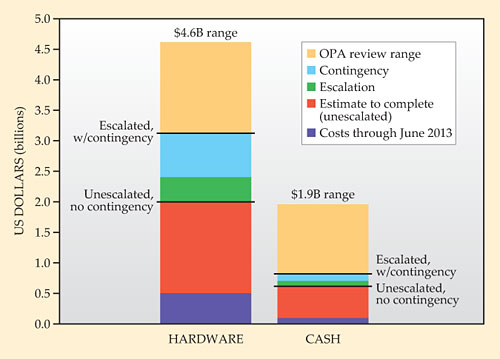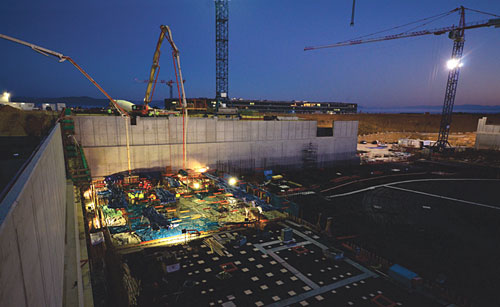US taking a hard look at its involvement in ITER
DOI: 10.1063/PT.3.2271
A Department of Energy internal review committee has concluded that the US share of ITER, the international project to build a fusion test reactor in Cadarache, France, could cost as much as $6.5 billion—$2.6 billion more than is estimated by DOE’s ITER project office. At the insistence of congressional appropriators who requested the figures, the Obama administration is now reviewing ongoing US participation in ITER. A possible shift in policy would be included in the department’s fiscal year 2015 budget request, the release of which reportedly has been delayed by at least one month from the first Monday in February date set by statute.
The US contribution to ITER consists mainly of components for the giant tokamak. A small fraction, though, would be in cash to pay for the US share of assembly costs and central office administration. Originally expected to cost €5 billion ($6.8 billion), ITER currently has no official price tag. (See Physics Today, July 2013, page 24
A DOE spokesperson said the department would not release details of the $6.5 billion estimate, which was prepared by the Office of Science’s office of project assessment (OPA), until a decision has been made. In a statement, Edmund Synakowski, DOE’s associate director of science for fusion energy sciences, said, “The new cost estimate, which is a range from $4.0 to $6.5 billion, is a reflection of the historical cost growth of the project and the high level of risk and uncertainty associated with this highly complicated international undertaking.”

A new cost estimate of the US contribution to ITER totals $6.5 billion and consists of both in-kind contributions (left) and cash. The US ITER project office’s estimate consists of all colors except for the yellow, which represents the amount that was added for contingency by DOE’s office of project assessment.
US ITER PROJECT OFFICE

Ned Sauthoff, director of the US ITER project office, told the nonprofit industry group Fusion Power Associates in December that his office stands behind its $3.9 billion US contribution estimate. He said his office included a contingency of $800 million (47%) on the remaining $1.5 billion of the US hardware contribution. (About $400 million worth of hardware has already been produced in the US.) The project office estimated the cash portion of the contribution would be $800 million, including the US share of a potential €1 billion operations overrun for ITER’s central offices in Cadarache, and $400 million to cover a cost escalation resulting from an expected three-year delay of ITER’s official 2020 completion date.
A worst-case scenario?
The OPA assessment tacked $1.5 billion onto the US project office’s $3.1 billion hardware cost estimate, including upping the contingency to 130%. The OPA review more than doubled the project office’s cash estimate, to $1.9 billion. “What [OPA] did was to answer the question, ‘How bad could it get—what is the outer bound on the cost?’ They took pessimistic assumptions,” Sauthoff said.
Ironically, US ambivalence to ITER is contributing to the cost escalation. The Obama administration has imposed a $225 million limit on the US annual contribution. At that rate, US obligations to the project won’t be finished until 2033—10 years after the expected date for completion of the reactor. Sauthoff estimated that the total US contribution to ITER could be reduced by as much as $500 million if the annual cap were eliminated.
Complicating matters, Congress has imposed a cap of $2.2 billion on the US total contribution for ITER’s construction phase. The other six ITER members—the European Union (EU), Japan, Russia, China, India, and South Korea—appear committed to contribute whatever it takes to build the reactor. The ITER Council, the ministerial-level body that is the project’s governing board, already has agreed to defer the cash portion of US contributions to a later date so that the entire annual payments can fund critical components.

Concrete pouring for the basement of the tokamak complex at ITER began in mid December. Fourteen more pour days will be required over six months to complete the 1.5-meter-thick slab that will support the weight of the tokamak, diagnostic, and tritium buildings.
ITER

Another look
Senator Dianne Feinstein (D-CA), who chairs the Appropriations subcommittee that funds DOE, has insisted that the administration reassess its commitment to ITER. “[She] put the onus on the White House and the administration to decide what to do,” says a Senate source. “The current approach is intolerable; either withdraw from the project or give it the necessary resources. We have to go higher than $225 million.” The administration should be able to find a few more million for several years to support the US’s largest international scientific project, he said, considering that the White House asked for a $1 billion increase for its energy efficiency and renewable energy programs in FY 2014.
Osamu Motojima, ITER director general, told the Fusion Power Associates meeting that the OPA’s numbers are too high compared with the EU’s estimate of €7.4 billion ($10.2 billion) to cover its 45% share of construction costs. Indeed, extrapolating the $6.5 billion estimate for the US’s 9.1% share would put ITER’s total cost well over $50 billion.
But the OPA review said the US ITER project office had underestimated the difficulty of obtaining seismic, safety, and tritium operating approvals from French regulatory authorities. It also was concerned that the ITER design is just 55% complete and that there is insufficient project management expertise at Cadarache to integrate so many components from such a variety of countries.
Meanwhile, the ITER Council is to consider the findings of a biennial external review of project management at a special meeting in France this month. Although the ITER Organization (IO) declined to release the review report, the Senate source says it urged major changes in IO staffing practices. Rather than having key technical positions designated for particular member nations, as is currently the case, the best-qualified individuals for those positions should be installed without regard to their nationality, the review said. The outcome of the council meeting will be critical in determining ITER’s cost, the Senate source says. Should the recommended reforms be implemented, they could bring the cost well below the upper OPA estimate.
Motojima said he agrees with all of the management review’s recommendations and is now taking steps to centralize construction management at the IO. The central office is working to reduce bureaucracy and simplify decision-making processes and approvals and will eliminate three of its nine directorates. Kattalai Sriram, director for ITER’s finance, budget, and management systems, said the IO had achieved 92% of milestones for “critical and supercritical” components—including the vacuum vessel, toroidal and poloidal field magnets, and the building that will house the reactor—during the year that ended August 2013. But he acknowledged that only 52% of milestones for all ITER’s components were met during that period.
The US and the former Soviet Union initiated ITER in the 1980s as a Cold War tension-easing cooperative science program. It was quickly joined by Japan and the EU. Bowing to pressure from Representative James Sensenbrenner (R-WI), then chairman of the House Science and Technology Committee, the US withdrew from the project in 1999. Since US reentry in 2003, much of the ITER contribution has been taken from the existing DOE budget for fusion, resulting in substantial reductions to the US domestic fusion research program.
More about the Authors
David Kramer. dkramer@aip.org
